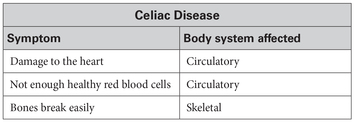This body system, made up of the heart and blood vessels, main function is carry blood and nutrients all over the body.
What is the circulatory system?
Groups of cells make this, which in turn make organs.
What are tissues?
The nervous system is made up of the brain, the spinal cord and approximately 7 trillion of these messengers.
What are nerves?
The facts that are absolutely true and used to support a claim.
What is evidence?
The body system that breaks down food into substances that can be absorbed and used for energy and gets rid of the remaining solid waste that cannot be absorbed.
What is the digestive system?
All the muscles of the body make up the muscular system and cause movement when they do this.
What is contract?
Requiring the most magnification, this is the smallest living thing.
What is a cell?
Using your hand and arm muscles to close the window after a bright flash of lightning and storm starts is an example of this.
What is a voluntary response?
Your explanation or interpretation of facts to help explain a claim.
What is reasoning?
A thin slice of an organ or tissue made by cutting through it.
What is a cross section?
Two systems working together to bring oxygen all over the body.
What are the respiratory and circulatory systems?
The shapes of cells that make up a tissue, the arrangement of cells and generally how the tissue looks.
What is structure?
Blinking after a bright flash of lightning is an example of this.
What is involuntary response?
Celiac disease is a condition in which the body mistakenly attacks and destroys finger-shaped structures lining the small intestine. These structures function to absorb and transport digested food to the rest of the body. The damage occurs when a person who has Celiac disease eats food containing a protein called gluten. Celiac disease has many different symptoms. The most common are not feeling very hungry, having diarrhea, and losing weight. After having celiac disease for a while, a patient may have other problems, too. Some of these are shown in the table.

Which statement about people with celiac disease is supported by the evidence?
A. They have damage to their digestive system which can later affect their circulatory system.
B. They have damage to their muscular system which can later affect their skeletal system.
C. They have damage to their excretory system which can later affect their digestive system.
D. They have damage to their respiratory system which can later affect their circulatory system.
What is answer choice A?
A typically self-contained structure that carries out a particular function for the body.
What is an organ?
The skeletal system is the framework of bones that supports an organism's body, allows the body to move and also does this.
What is protect its internal structures?
Each tissue has a different one of these, depending on its structure and where it is located.
What is a function?
A person's reaction time might be longer if they are doing many things at one time. This is called what?
What is multitasking?
Scientists who research diseases know that healthy tissues have different characteristics than unhealthy tissues. Sometimes how elastic (stretchy) a tissue sample is can tell a scientist whether that tissue is healthy or not. For example, an unhealthy piece of bone tissue may be more elastic than a healthy piece of bone tissue.
Elasticity in tissues is measured in a unit called a Pascal. A low number of Pascals means that a tissue is more elastic, while a high number of Pascals means that a tissue less elastic. The following table shows approximate elasticities in certain types of healthy tissue.
Which statement is supported by the evidence in the table?
A. Muscle tissue is more elastic than nerve tissue.
B. Connective tissue is the most elastic tissue in the body.
C. The tissue in the walls of arteries is more elastic than epithelial tissue.
D. The tissue that makes up the brain is the most elastic tissue.
What is answer choice D?
A change in the internal or external environment that causes the nervous system to react
What is a stimulus?
In addition to getting rid of waste, one of the important functions of the excretory system is to do this using your kidneys.
What is regulate the amount of water in the body?
When it comes to absorbing nutrients or oxygen, the more of this, the better. This is because every organ in the body is structured to carry out its function effectively. (HINT: think folds in intestines and many tiny air sacs)
What is surface area?
A thought, memory, emotion or learning are considered this type of response to stimuli.
What are non-motor responses?
Kevin does some research and discovers that the digestive system breaks down food in two ways. One way is mechanically, by grinding and mashing food to make smaller pieces. The other way is changing the food into other substances that can be absorbed using chemical reactions. Kevin makes a table of his notes. Which statement below is supported by the evidence found by Kevin's research?
A. Mechanical breakdown of food requires all of the digestive system's organs.
B. Structures in the digestive system sometimes have more than one function.
C. The main function of the digestive system is to mechanically break down food.
D. Chemical breakdown of food is the most important function of the digestive system.
What is answer B?
Unlike most other body systems, this system is not fully functional as soon as you are born.
What is the reproductive system?